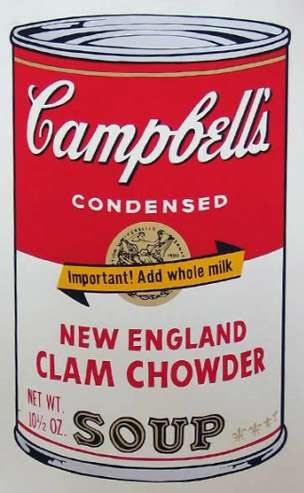Say chowder out loud: chowder. The word sounds like food. Not an appetizer either. An entree in a small crock topped with broken crackers.
As with so many things related to food, chowder is a storied dish. It hails from New England and northeastern Canada, its first written reference dating back to 1732 when a journalist recalls dining on a “fine chowdered cod.”
There are as many types of chowder as there are soup, though a true chowder is more like a stew than a soup. Some purists would rather eat slugs than a chowder with tomatoes in it or whose name references New York. But all chowders must feature the following: broth, salt pork, biscuit and seafood.
Aside from that, all bets are off. Chow down.
Of course a regional dish with this long a history and which leaves this much room for interpretation deserves a history of its own, and so the good people at the University of Massachusetts, Amherst created the New England Chowder Compendium, a collection of recipes and ephemera exploring how chowder rose to become a staple of New England cookery.
Culled from cookbooks held by the university’s Beatrice McIntosh Cookery Collection, the compendium chronicles chowder recipes from the 1700s to the 1970s, through lean times and fat, through recipes heavy with cream and without.
And so, as readers click through featured chowder recipes from the 1920s on through to the 1940s, they’re sure to notice the ways ingredients vary. Use evaporated milk and a little water, if cream is not available. Housewives were wise in the 1940s to be thrifty while making fresh stock from knuckles: Save that fat that rose to the top and sell it to your meat dealer.
Chowder may be one of the poster food for people who are making do. Don’t have fresh seafood? Canned tuna will do. Lima beans soaked overnight can substitute for clams.
As with most handwritten recipes, the handwriting and illustrations are part of the fun. One radical suggests adding a dash of paprika. This recipe, for the Kingston Yacht Club, may have fed the entire membership (three gallons of clams?!)
The archivists include a nice primer, tracing the development of chowder (the word comes from French for “cauldron”).
One recipe that doesn’t sound so good: diet chowder from the 1970s.
Kate Rix writes about digital media and education. Read more of her work at and at thenifty.blogspot.com.



While I don’t wish to be gratuitously pedantic, I think your assertion that “all chowders must feature the following: broth, salt pork, biscuit and seafood” can only be considered correct if the point that one is trying to make is that one prefers being gratuitously authoritarian. Wiktionary, for example, defines chowder as “(1) A thick, creamy soup or stew and (2) a stew, particularly fish or seafood, not necessarily thickened”, while Wikipedia argues that chowder is “a seafood or vegetable stew (or thickened soup), often served with milk or cream and mostly eaten with saltine crackers”, mentioning corn chowder and potato chowder (a favourite of mine) as two examples that do not conform to your proposed necessary and sufficient requirements. Thus I should like to counter-propose that in practice chowder is in fact any foodstuff which generally evokes in the eater thereof the feeling or emotion that “this tastes like some kind of chowder”, which given the lack of any sort of formally authoritative English definition I would argue comes closer to a true and correct characterization of the semantics of chowder. Other than that, thanks for the links. I love chowders, especially when more than ¼ of the composition thereof consists of butter-fat ☺